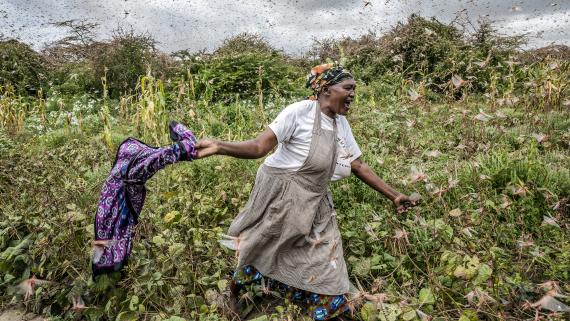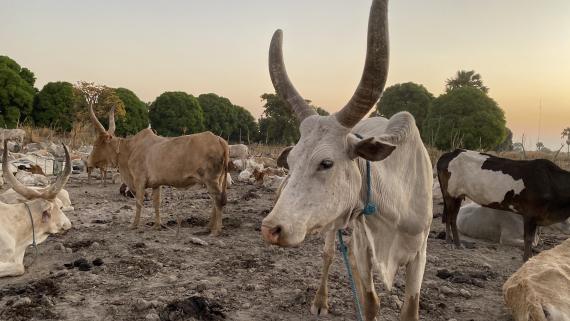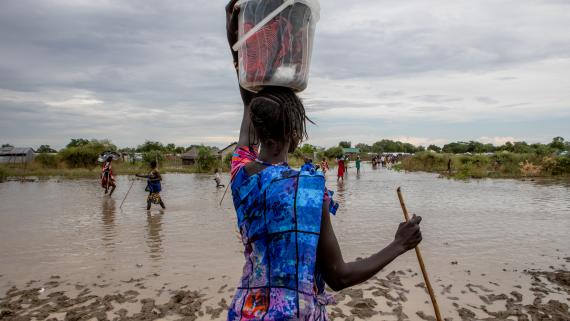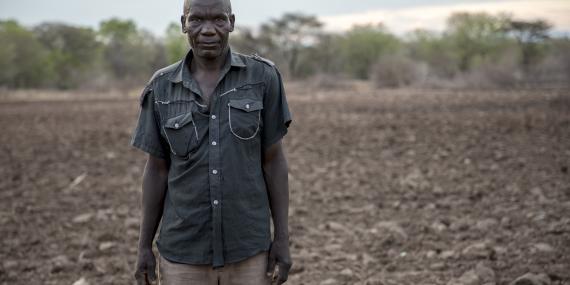Munyuki, Zimbabwe
A farmer in Munyuki village, Mazambara district, cultivates cotton, maize and sorghum. He has been badly affected by drought and the economic crisis. “If I compare the temperatures between when I was a boy and now, it’s hotter and drier than before," he said. "Never have I lost two rounds of planting to drought. In Zimbabwe the first rains used to come in October, but now they are getting later.” WFP/Matteo Cosorich
The last decade was the hottest on record. Climate change continues to seriously challenge humanitarian response efforts. Increasingly severe weather and rising numbers of natural disasters are exacerbating chronic vulnerabilities.
In 2019, 396 natural disasters were reported, above the annual average of the last 10 years (343 disasters per year), killing 11,755 people, affecting nearly 95 million others and causing approximately $150 billion in losses. Natural disasters triggered 24.9 million new displacements in 2019, the highest recorded figure since 2012. By 30 June 2020, 9.8 million people had been newly displaced by disasters. This figure is expected to rise, as displacements are yet to be accounted for from major flooding in Asia and the Sahel region, and the typhoon season in East Asia and the Pacific.
Disaster events by type (1980-2019)
Climate change and extreme weather events are key drivers of the recent rise in global hunger and food insecurity. In 2019, 34 million people suffered from weather-driven acute food insecurity – a 17 per cent increase from the previous year. These numbers are expected to rise, as more than 80 per cent of the world’s most food insecure people live in disaster-prone countries. Swarms of desert locusts, triggered by unusual weather conditions, are threatening large areas of pastures and crops in the Horn of Africa, the Middle East and South Asia. The 2020 locust outbreak represented the worst infestation in 25 years in Somalia and Ethiopia, and the worst in 70 years in Kenya.
Climate change disproportionately affects the poor and vulnerable. Children make up nearly half of those affected by disasters, and women and girls often lack access to resources and assets to cope with disasters. People in poverty, indigenous people and small-scale landholders are increasingly vulnerable due to a high level of income dependence on agriculture, fishing and ecosystems. Agriculture, a vital sector in the poorest countries, is most affected by climatic changes, threatening export earnings, livelihoods, sources of income and food security.
Climate change

The locust outbreak, brought about by weather variations, represented the worst infestation in 25 years in Somalia and Ethiopia, and 70 years in Kenya.
Photo: FAO
In 2020, 8 of the 10 countries most vulnerable to the effects of climate change also had an inter-agency humanitarian appeal.
OCHA
Children make up nearly half of those affected by disasters.
Photo: UNICEFPeople caught in humanitarian crises were already among the most vulnerable to the impacts of climate change. They are now under even more strain due to the secondary effects of COVID-19, such as loss of livelihoods, reduced capacity to cope with shocks and increasing food insecurity. In 2020, 8 of the 10 countries most vulnerable to the effects of climate change also had an inter-agency humanitarian appeal. All these countries are among those considered most at risk from the impacts of COVID-19, as determined by the INFORM COVID-19 Risk Index.
INFORM Risk Index: Hazard and Exposure vs. Coping Capacity
Mobility restrictions due to COVID-19 are having unexpected effects on global weather-observing systems. The limitation of critical observation and measurement activities has affected the quality of forecasts and other weather-, climate- and ocean-related services, potentially compromising weather alert systems. The reduction of aircraft-based observations by an average of 75 to 80 per cent in March and April 2020 degraded the forecast skills of weather models. Observations at manually operated weather stations, especially in Africa and South America, have also been badly disrupted. In March 2020, nearly all oceanographic research vessels were recalled to home ports. Four full-depth ocean surveys of variables such as carbon, temperature, salinity and water alkalinity completed only once per decade have been cancelled. Poorer weather observation may impact climate-related warnings that protect lives and property, increasing the vulnerability of people already vulnerable to climate change.
Further reading
Source: WMO
Source: CRED / UNDRR
Source: WMO
References
- World Meteorological Organization, Statement on the State of the Global Climate in 2019
- Excluding epidemics and insect infestations; Center for Research on the Epidemiology of Disasters, Disaster Year in Review (2019)
- Munich RE Natural disasters in 2019
- Internal Displacement Monitoring Centre, Global Report on Internal Displacement 2020, 28 April 2020
- Internal Displacement Monitoring Centre, Internal displacement 2020: mid-year update, 23 September 2020
- Food Security Information Network, 2020 Global Report on Food Crises – Joint Analysis for Better Decisions, 21 April 2020
- World Food Programme, 14 Facts Linking Climate, Disasters, and Hunger
- Food and Agriculture Organization of the United Nations, FAO Appeals for Urgent Support to Fight Worsening Desert Locust Upsurge in the Horn of Africa, 30 January 2020
- IFRC, We Need to Do Better, Policy Brief for Enhancing Laws and Regulations to Protect Children in Disasters
- UNEP, UN Women, DPPA, UNDP: Gender, Climate & Security: Sustaining Inclusive Peace on the Frontlines of Climate Change
- UNDESA, World Social Report 2020: Inequality in a Rapidly Changing World
- World Bank, Shock Waves: Managing the Impacts of Climate Change on Poverty
- As determined by the Notre Dame Global Adaptation Initiative, University of Notre Dame
- Afghanistan, Central African Republic, Chad, Democratic Republic of the Congo, Haiti, Niger, Somalia, Sudan
- WMO United in Science 2020, September 2020





